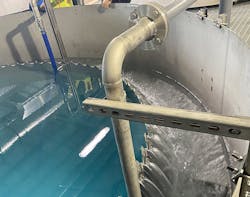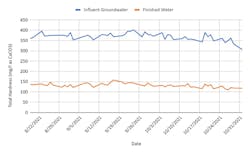Minimizing Softening Waste Disposal Costs
The Client
South Adams County Water and Sanitation District (SACWSD) operates the Klein Water Treatment Facility, treating drinking water for the Commerce City, CO area with approximately 66,000 residents.
The Client’s Needs
SACWSD has historically provided a blended water source to its potable water customers. This blend consisted of water purchased from Denver Water and that from the local groundwater supply. The local groundwater supply is considered to be hard with total hardness levels around 350 mg/L.
Blending the two water sources reduced the hardness levels in the finished water but enough hardness remained to allow for calcium carbonate precipitation within the distribution system. In 2017, SACWSD formed a Hardness Advisory Committee (HAC) to get community recommendations on the course of action for addressing water hardness in the District’s potable supply. After looking at numerous options, the HAC suggested, and the Board of Directors approved, hardness treatment with pellet softening.
The Solution
Veolia has over 25 years of experience designing and commissioning pellet softening systems with over 50 installations worldwide.
To address HAC recommendations, Veolia provided three 4.6 MGD Actina™ Pellet Softening reactors for the SACWSD project. In addition to the Actina reactors, ancillary equipment such as a seed feed and storage system, instrumentation, controls and suspended caustic distribution units were provided to treat an average influent hardness of 350 mg/L.
The Benefits
- Produced waste pellets are used for animal feed supplement
- Meets District’s goal of 115 mg/L +/- 10% total hardness
- Minimizes distribution network scaling issues
- Provides “clean” footprint compared to lime/soda softening
Process Description
The Actina™ pellet softening reactors include custom designed flow distribution nozzles that ensure homogeneous fluidized bed expansion and minimizes wear on the internal reactor walls.
The Actina™ system removes hardness by producing easily dewatered and reusable waste pellets. The pellets replace the membrane brine or lime sludge disposal challenges associated with other softening processes, which in return reduces waste disposal and overall operating costs.
Table 1. represents influent and softened water total hardness values generated at the SACWSD facility from August to October 2021. Over this time period, the caustic dose ranged from 130-180 mg/L resulting in 2,600 lbs of pellets per million gallons treated.
Results
In addition to providing higher quality water at optimal operating costs, the Actina pellet softening system also allows SACWSD to provide all of their waste pellets to an agricultural feed user as a calcium supplement. This currently provides cost-free disposal while providing ecological benefits of reusing a waste product for animal feed. As an example, in the first six months of operation SACWSD was able to repurpose over 4.1 million pounds of pellets to the local agricultural feed user rather than disposing of the waste in a landfill.
Editor's Note: Scranton Gillette Communications and the SGC Water Group are not liable for the accuracy, efficacy and validity of the claims made in this piece. The views expressed in this content do not reflect the position of the editorial teams of Water & Wastes Digest, Water Quality Products and Storm Water Solutions.

